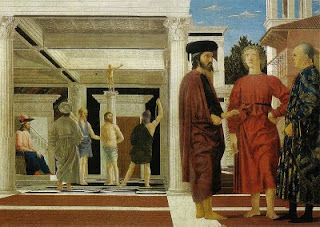
With a little delay this post is about the last day of my summer trip.
Urbino is fabulous. We went for a walk in the evening and found out that Palazzo Ducale opened in the morning at 8.30 so the next day were the first visitors, and the guards were opening each rooms as we came in.
What an experience to be alone with the paintings. There are two masterpieces by Piero in Urbino, and they share the same room.

The Madonna di Senigallia was a complete surprise for me, I think I overlooked it while browsing through Piero's paintings.
It's elegance and balance are stunning.
The draping, jewels and the little basket on the upper right corner are all executed with chilling realism, while the heads are idealized and pure. I feel that this painting is visually very much about the position of the heads and their relative size.
I spent a long time staring at it and taking in its vertical and horizontal rhythm, the chiaroscuro barely hinted at, the perfection of the simple blue and red colour scheme.

"La Flagellazione" is one of the most famous paintings of Piero, and it's size is quite a surprise, only 58x81 cm. Small size for an immense work. Enough has been said about it's elusive meaning. Standing in front of this work as a painter I was wondering what it was I was connecting with.
I think that the absence of strong passion, of movement is what I liked. The flagellation is stilled in mid air, Christ is just looking at his torturer, the man in the black hand is making a gesture as if to quiet the action.
This perfect harmony of stillness is something I always found appealing in painting. The composition here is so perfect that it is impossible the action will ever begin again, that time would re-start.
Is it the use of geometry and mathematics that imparts this sublime balance to the painting? Does the regular rhythm of the darks help, or the simple three values scheme?
These are all elements I will have to remember when I work.
PS: Sir Charles Locke Eastlake opted not to buy the painting for Queen Victoria in 1858 because of some features which offended his taste, notably the thick ankles !
No comments:
Post a Comment